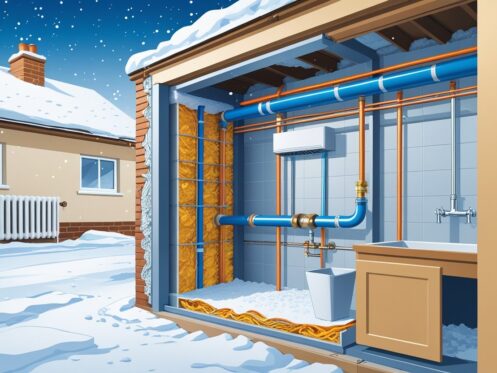As winter approaches, the risk of your water pipes freezing becomes a serious concern. Keeping your pipes warm and properly insulated can prevent damage and costly repairs. Take steps like maintaining your home’s thermostat above 55 degrees and allowing a trickle of water to flow through your faucets during extreme cold.
Consider wrapping exposed pipes with insulation or heating tape to minimize the chances of freezing. In addition, open cabinet doors under sinks to let warmer air circulate around the plumbing. If you’re uncertain or need professional assistance, Splash Plumbing is a top-rated plumbing company available to address your concerns in Anaheim, CA.
Taking proactive measures now can save you from headaches later. By following these tips and keeping your plumbing system well-maintained, you’ll ensure a worry-free winter. Reach out to Splash Plumbing if you encounter any issues or need expert guidance.
Understanding Why Water Pipes Freeze
Water pipes can freeze when temperatures drop significantly, leading to various problems for homeowners. Understanding why this happens can help you take preventative measures to protect your plumbing system from damage.
How Freezing Temperatures Affect Pipes
When temperatures fall below 32°F (0°C), the water inside your pipes can freeze. As water freezes, it expands, putting immense pressure on the pipe walls. This can cause weaker sections of your plumbing system to rupture, resulting in a burst pipe. Exposed pipes, particularly those in unheated areas like crawlspaces or attics, are more susceptible to freezing. Keeping your home warm and allowing a trickle of water to flow can help keep pipes in these areas from freezing.
Risks and Consequences of Frozen Pipes
The risks associated with frozen pipes include serious property damage and costly repairs. A burst pipe can lead to significant water damage, compromising your home’s structure and leading to mold growth. The resulting flooding can not only damage your floors and walls but also ruin personal belongings. Additionally, repairs may involve not just fixing the pipe but also addressing the damage caused by the water. To mitigate risks, ensure your plumbing system is winterized properly before cold weather hits.
Common Problem Areas in the Home
Certain areas in your home are more prone to freezing pipes. These include:
- Crawlspaces: Often uninsulated, crawlspaces expose pipes to cold air.
- Attics: These are frequently left unheated, especially in colder months.
- Exterior Walls: Pipes running through exterior walls can freeze quickly.
To prevent issues, consider insulating these pipes with foam sleeves, and make sure to seal any drafts that may lead cold air to these vulnerable areas. If you’re unsure about how to protect your plumbing, consult with professionals like Splash Plumbing for tailored advice.
Essential Preventative Measures
To prevent your water pipes from freezing, you need to focus on insulation, sealing vulnerable areas, and strategically applying heat. Implementing these measures can significantly reduce the risk of pipe bursts during cold weather.
Proper Insulation Techniques
Effective insulation is crucial in maintaining the temperature of your pipes. Ensure that all exposed pipes, especially those in unheated areas like attics and basements, are adequately insulated with materials such as foam sleeves or fiberglass insulation.
Use insulation tape to cover joints and transitions, ensuring a snug fit. If you live in particularly cold climates, consider adding an additional layer of insulation.
For pipes in cabinets, leave the doors open during cold spells to allow warm air to circulate. Regularly check insulation for wear and replace any sections that appear deteriorated. Properly insulated pipes can maintain higher temperatures and are less likely to freeze.
Sealing and Caulking Vulnerable Areas
Identifying and sealing drafty areas in your home is a vital step in protecting your pipes. Look for gaps around windows, doors, and where pipes enter your home; these places can let in cold air, increasing the risk of freezing.
Use caulk for smaller cracks and gaps. For larger holes, consider using expanding foam insulation. Pay special attention to areas where plumbing penetrates walls or foundations—these are often overlooked.
Maintaining a sufficiently sealed home environment helps retain heat and ensures that your plumbing is protected from extremely low temperatures. Regular checks and maintenance of these seals can prevent costly plumbing issues from developing.
Strategic Use of Heat Tape and Heating Cables
Heat tape and heating cables are valuable tools for keeping your pipes warm. These products can be applied directly to the pipes, providing a consistent heat source.
When choosing heat tape, ensure it is designed for the specific purpose of pipe protection. Installation is typically straightforward; wrap the tape around the pipe according to the manufacturer’s instructions.
Also, consider using these methods in conjunction with insulation for the best results. Always check for any exposed wiring or signs of wear to prevent potential hazards. Heat cables can dramatically lower the chance of your pipes freezing, especially in vulnerable areas.
If you need assistance with preventing frozen pipes, Splash Plumbing can provide expert advice and services tailored to your home’s plumbing needs.
Winterization Tips for Protecting Pipes
Proper winterization is essential to prevent water pipes from freezing during the colder months. By taking a few proactive steps, you can protect your plumbing system and avoid expensive damage.
Winterizing Outdoor Hose Bibs and Faucets
Start by disconnecting and draining garden hoses from outdoor hose bibs. This prevents water from remaining in the hose, which can freeze and expand. For exterior faucets, install insulated covers or faucet socks to provide an extra layer of protection against freezing temperatures.
You may also want to check for any leaks in the faucet itself. Fixing these leaks will ensure that no water collects and freezes inside the fixtures. If you live in an area with particularly harsh winters, consider shutting off the water supply to outdoor faucets and draining them completely.
Preparing Unused or Seasonal Plumbing Lines
If you have plumbing lines that won’t be in use during the winter, such as lines for swimming pools or irrigation systems, it’s vital to drain them fully. Follow these steps:
- Turn off the water supply to the lines.
- Open any valves to allow water to escape.
- Blow out any remaining water using an air compressor if appropriate.
For washing machines, disconnect hoses and inspect them for any signs of wear. Store them in a warm place if possible. This ensures that your seasonal plumbing lines remain protected from freezing.
Insulating Garages and Crawlspaces
Garages and crawlspaces can be significant sources of heat loss, leading to frozen pipes. Insulate these areas by sealing any drafts around doors and windows, and installing insulation on walls and ceilings.
Consider adding heat tape or heating cables along vulnerable pipes. Make sure to leave garage doors closed as much as possible during cold weather. If temperatures drop significantly, you might keep a heater running at a low setting to maintain an appropriate temperature in these enclosed spaces.
For comprehensive plumbing services in Orange County, contact Splash Plumbing. Our experienced team can help ensure your plumbing is ready for winter.
Best Practices for Maintaining Water Flow
Maintaining consistent water flow is crucial, especially during extreme cold. Simple actions can help prevent your pipes from freezing, ensuring that water continues to run smoothly in your home. Implementing smart management of your water shut-off valves is equally important to avoid emergencies.
Keeping Water Running During Extreme Cold
To prevent frozen pipes, keep water running in your home when temperatures drop significantly. Dripping faucets can be effective; even a slow trickle can maintain water flow. Focus on the faucets that are furthest from your main water supply line, as they are more susceptible to freezing.
Set your home thermostat to a minimum of 55°F. This helps ensure that ambient temperatures near your pipes remain warm enough to prevent freezing. Open cabinet doors under sinks to allow warmer air to circulate around your plumbing. Regular checks on your plumbing system will alert you to any early signs of freezing.
Managing Water Shut-Off Valves
Understanding the various water shut-off valves in your home is essential for effective management. Familiarize yourself with the main shut-off valve, which controls water flow to your entire house. Knowing its location allows for quick action if you experience a burst pipe.
Additionally, inspect all shut-off valves regularly to ensure they function correctly. Valve failure can lead to significant issues when an emergency arises. If you’re unsure about the operation or condition of your valves, consider contacting a professional. Splash Plumbing can assist with inspections and ensure your water systems are ready for any scenario.
Thawing Frozen Pipes Safely
Thawing frozen pipes requires careful attention and specific methods to avoid damage. Using the right techniques can prevent issues like burst pipes and significant property damage. Proper application of heat is critical, and knowing when to seek professional help can save you time and money.
How to Apply Heat Correctly
Start by turning on the faucet connected to the frozen section. This allows water to flow once the ice starts melting. Next, apply heat directly to the frozen area using a hair dryer or a heat gun. Never use an open flame as this poses a fire hazard. Focus on moving the heat source along the pipe evenly to avoid damaging it. If the pipe is insulated, peel back the insulation first. Patience is crucial; slowly thawing the pipe will reduce the risk of a burst.
Using Space Heaters and Electric Heating Pads
Space heaters can effectively warm the area around frozen pipes. Positioning a space heater safely away from any flammable materials helps raise the ambient temperature. Alternatively, wrapping pipes with an electric heating pad is another safe option. Ensure the heating pad is secured and turned on, keeping it plugged in according to the manufacturer’s instructions. This method can provide a steady and controlled amount of heat, aiding the thawing process without excessive risk.
When to Call a Professional Plumber
If you cannot locate the frozen pipe, or if the pipe does not begin to thaw after applying heat, it’s time to contact a professional plumber. Signs of serious trouble include gurgling sounds or visible bulging in the pipe. These symptoms can indicate that a burst pipe is imminent, leading to costly property damage. Splash Plumbing can assess the situation, ensuring your plumbing system remains intact. Don’t risk further issues; seeking help early can prevent severe consequences.
Frequently Asked Questions
When it comes to preventing water pipes from freezing, there are several effective measures and strategies you can implement. These techniques include specific precautions for outdoor pipes, alternative methods when heating is unavailable, and key temperatures to watch for.
What measures can prevent outdoor water pipes from freezing?
To safeguard outdoor water pipes, disconnect garden hoses and drain them completely. Insulating outdoor faucets with foam covers can also provide protection. Additionally, you may want to consider installing heat tape on exposed pipes to provide extra warmth during freezing temperatures.
What are the alternative methods to prevent pipe freezing when there’s no heat available?
If you lack consistent heating, let faucets drip to keep water moving. This can reduce the risk of freezing. Insulating pipes with materials like towels or blankets can also help, though they shouldn’t be left unattended for long periods.
At which temperature should homeowners start to take precautions against frozen pipes?
Homeowners should begin taking precautions when temperatures drop to 20 degrees Fahrenheit or lower. Pay attention to wind chill as it can exacerbate the risk of freezing, especially for pipes located near exterior walls.
Is there a need to keep water running to prevent the pipes from freezing, and if so, should it be hot or cold?
Allowing a small trickle of water to run is beneficial to prevent freezing. It is generally recommended to let cold water run, as hot water can put additional stress on your plumbing system and may lead to other issues.
Can the water supply be turned off to safeguard against pipe freezing, and what are the implications?
Yes, turning off the water supply can help prevent frozen pipes when you are away from home. However, be aware that this may affect other plumbing fixtures and could lead to complications if left for long periods without supervision.
What materials or products are recommended for insulation to protect pipes from freezing temperatures?
Insulating your pipes can be done with foam pipe insulation, which is widely available. Alternatively, you might use fiberglass insulation for larger areas. Heat tape is also effective for maintaining warmth along pipes in critical areas.
For expert help in dealing with plumbing issues or installations, consider contacting Splash Plumbing, a trusted plumbing service ready to assist you with all your needs.












